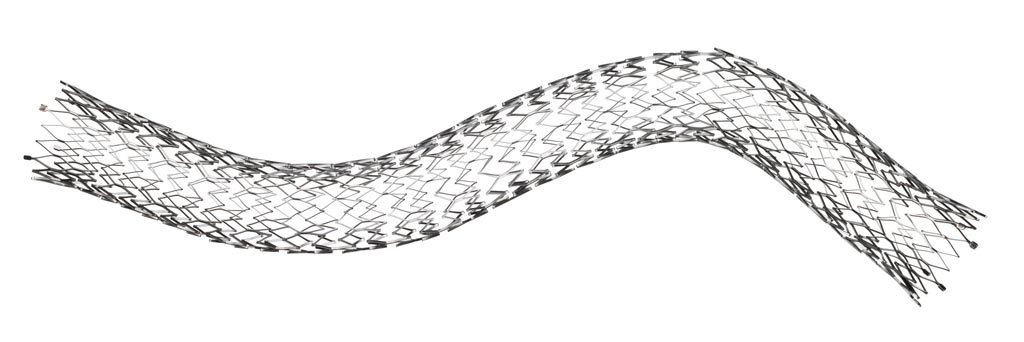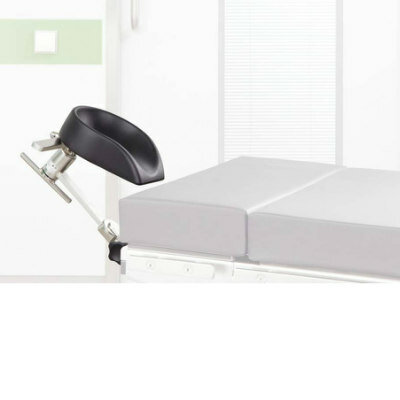Flexible Stent Treats Iliofemoral Venous Occlusive Disease
|
By HospiMedica International staff writers Posted on 25 Mar 2019 |

Image: The Venovo stent is specifically designed for arteries (Photo courtesy of BD).
A novel stent treats iliofemoral venous occlusive disease (IVOD), the obstruction or narrowing of blood flow specific to the iliac and femoral veins, located near the groin.
The BD (Franklin Lakes, NJ, USA) Venovo venous stent is specifically designed to reopen blocked iliac and femoral veins in order to maintain adequate blood flow in symptomatic IVOD post-thrombotic and non-thrombotic lesions. The flexible nitinol stent maintains a balance of radial strength, compression resistance, and flexibility specifically designed to meet the demands of veins, as opposed to arteries. For example, the ends are flared to enhance vein-wall apposition, and broad stent sizing allows clinicians to treat large diameter veins (10-20 mm) and long lesion lengths (from 40 mm to 160 mm). Six radiopaque tantalum markers aid in positioning.
A prospective, multicenter, single-arm trial involving 170 patients showed a weighted primary patency rate of 88.3%, with a 96.9% patency rate in non-thrombotic lesions and an 81.3% patency rate in post-thrombotic lesions at 12 months, exceeding the performance goal of 74%. In addition, patients treated with the Venovo reported a significant reduction in pain symptoms and improvement in quality of life at 12 months from baseline. The Venovo venous stent was also deployed successfully to the target lesion and showed adequate coverage in all cases, and there were no fractures seen at 12 months.
“The Venovo venous stent represents a significant advance for interventionalists treating iliofemoral venous occlusive disease, an under recognized condition,” said Steve Williamson, worldwide president of peripheral intervention at BD. "We designed the Venovo venous stent in collaboration with clinicians to enable them to treat both post-thrombotic and non-thrombotic lesions. Clinicians will now have access to the broadest range of stent sizes in the United States for these difficult-to-treat lesions.”
“The unique attributes of the Venovo stent make it particularly well-suited to treat iliofemoral occlusive disease,” said Michael Dake, MD, of the University of Arizona, the principal investigator for the Venovo U.S. Food and Drug Administration (FDA) investigational device exemption (IDE) trial. “Most importantly, it is purpose-built for application in veins, and engineered to address the special challenges of venous lesions that are very different than those posed by arterial narrowing.”
IVOD occurs when there is impaired blood flow in the iliofemoral vein caused by acute or chronic deep-vein thrombosi (DVT), post-thrombotic syndrome, iliofemoral vein compression (including May-Thurner Syndrome), or a combination of these diseases. Symptoms include swelling of the legs, pain when standing, skin discoloration and ulcers.
The BD (Franklin Lakes, NJ, USA) Venovo venous stent is specifically designed to reopen blocked iliac and femoral veins in order to maintain adequate blood flow in symptomatic IVOD post-thrombotic and non-thrombotic lesions. The flexible nitinol stent maintains a balance of radial strength, compression resistance, and flexibility specifically designed to meet the demands of veins, as opposed to arteries. For example, the ends are flared to enhance vein-wall apposition, and broad stent sizing allows clinicians to treat large diameter veins (10-20 mm) and long lesion lengths (from 40 mm to 160 mm). Six radiopaque tantalum markers aid in positioning.
A prospective, multicenter, single-arm trial involving 170 patients showed a weighted primary patency rate of 88.3%, with a 96.9% patency rate in non-thrombotic lesions and an 81.3% patency rate in post-thrombotic lesions at 12 months, exceeding the performance goal of 74%. In addition, patients treated with the Venovo reported a significant reduction in pain symptoms and improvement in quality of life at 12 months from baseline. The Venovo venous stent was also deployed successfully to the target lesion and showed adequate coverage in all cases, and there were no fractures seen at 12 months.
“The Venovo venous stent represents a significant advance for interventionalists treating iliofemoral venous occlusive disease, an under recognized condition,” said Steve Williamson, worldwide president of peripheral intervention at BD. "We designed the Venovo venous stent in collaboration with clinicians to enable them to treat both post-thrombotic and non-thrombotic lesions. Clinicians will now have access to the broadest range of stent sizes in the United States for these difficult-to-treat lesions.”
“The unique attributes of the Venovo stent make it particularly well-suited to treat iliofemoral occlusive disease,” said Michael Dake, MD, of the University of Arizona, the principal investigator for the Venovo U.S. Food and Drug Administration (FDA) investigational device exemption (IDE) trial. “Most importantly, it is purpose-built for application in veins, and engineered to address the special challenges of venous lesions that are very different than those posed by arterial narrowing.”
IVOD occurs when there is impaired blood flow in the iliofemoral vein caused by acute or chronic deep-vein thrombosi (DVT), post-thrombotic syndrome, iliofemoral vein compression (including May-Thurner Syndrome), or a combination of these diseases. Symptoms include swelling of the legs, pain when standing, skin discoloration and ulcers.
Latest Surgical Techniques News
- Minimally Invasive Endoscopic Surgery Improves Severe Stroke Outcomes
- Novel Glue Prevents Complications After Breast Cancer Surgery
- Breakthrough Brain Implant Enables Safer and More Precise Drug Delivery
- Bioadhesive Sponge Stops Uncontrolled Internal Bleeding During Surgery
- Revolutionary Nano Bone Material to Accelerate Surgery and Healing
- Superior Orthopedic Implants Combat Infections and Quicken Healing After Surgery
- Laser-Based Technique Eliminates Pancreatic Tumors While Protecting Healthy Tissue
- Surgical Treatment of Severe Carotid Artery Stenosis Benefits Blood-Brain Barrier
- Revolutionary Reusable Duodenoscope Introduces 68-Minute Sterilization
- World's First Transcatheter Smart Implant Monitors and Treats Congestion in Heart Failure
- Hybrid Endoscope Marks Breakthrough in Surgical Visualization
- Robot-Assisted Bronchoscope Diagnoses Tiniest and Hardest to Reach Lung Tumors
- Diamond-Titanium Device Paves Way for Smart Implants that Warn of Disease Progression
- 3D Printable Bio-Active Glass Could Serve as Bone Replacement Material
- Spider-Inspired Magnetic Soft Robots to Perform Minimally Invasive GI Tract Procedures
- Micro Imaging Device Paired with Endoscope Spots Cancers at Earlier Stage
Channels
Critical Care
view channel
Light-Based Technology to Measure Brain Blood Flow Could Diagnose Stroke and TBI
Monitoring blood flow in the brain is crucial for diagnosing and treating neurological conditions such as stroke, traumatic brain injury (TBI), and vascular dementia. However, current imaging methods like... Read more
AI Heart Attack Risk Assessment Tool Outperforms Existing Methods
For decades, doctors have relied on standardized scoring systems to assess patients with the most common type of heart attack—non-ST-elevation acute coronary syndrome (NSTE-ACS). The GRACE score, used... Read morePatient Care
view channel
Revolutionary Automatic IV-Line Flushing Device to Enhance Infusion Care
More than 80% of in-hospital patients receive intravenous (IV) therapy. Every dose of IV medicine delivered in a small volume (<250 mL) infusion bag should be followed by subsequent flushing to ensure... Read more
VR Training Tool Combats Contamination of Portable Medical Equipment
Healthcare-associated infections (HAIs) impact one in every 31 patients, cause nearly 100,000 deaths each year, and cost USD 28.4 billion in direct medical expenses. Notably, up to 75% of these infections... Read more
Portable Biosensor Platform to Reduce Hospital-Acquired Infections
Approximately 4 million patients in the European Union acquire healthcare-associated infections (HAIs) or nosocomial infections each year, with around 37,000 deaths directly resulting from these infections,... Read moreFirst-Of-Its-Kind Portable Germicidal Light Technology Disinfects High-Touch Clinical Surfaces in Seconds
Reducing healthcare-acquired infections (HAIs) remains a pressing issue within global healthcare systems. In the United States alone, 1.7 million patients contract HAIs annually, leading to approximately... Read moreHealth IT
view channel
Printable Molecule-Selective Nanoparticles Enable Mass Production of Wearable Biosensors
The future of medicine is likely to focus on the personalization of healthcare—understanding exactly what an individual requires and delivering the appropriate combination of nutrients, metabolites, and... Read moreBusiness
view channel
Philips and Masimo Partner to Advance Patient Monitoring Measurement Technologies
Royal Philips (Amsterdam, Netherlands) and Masimo (Irvine, California, USA) have renewed their multi-year strategic collaboration, combining Philips’ expertise in patient monitoring with Masimo’s noninvasive... Read more
B. Braun Acquires Digital Microsurgery Company True Digital Surgery
The high-end microsurgery market in neurosurgery, spine, and ENT is undergoing a significant transformation. Traditional analog microscopes are giving way to digital exoscopes, which provide improved visualization,... Read more
CMEF 2025 to Promote Holistic and High-Quality Development of Medical and Health Industry
The 92nd China International Medical Equipment Fair (CMEF 2025) Autumn Exhibition is scheduled to be held from September 26 to 29 at the China Import and Export Fair Complex (Canton Fair Complex) in Guangzhou.... Read more













